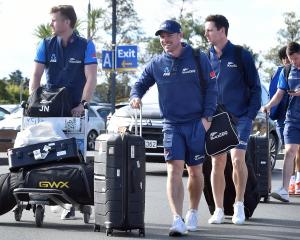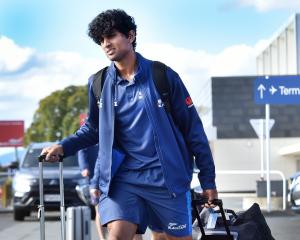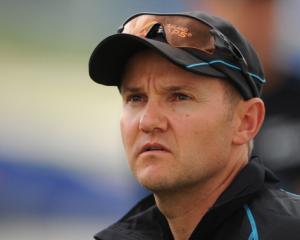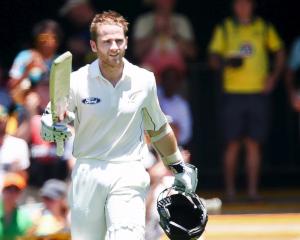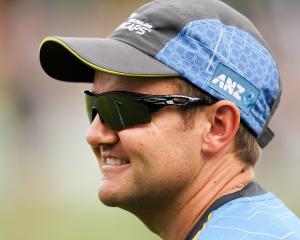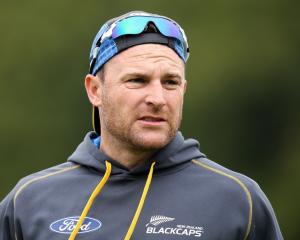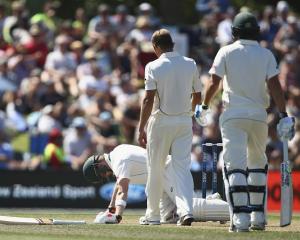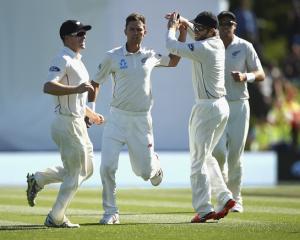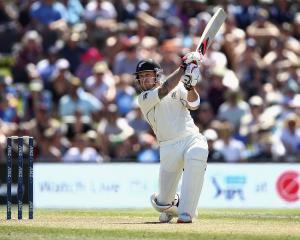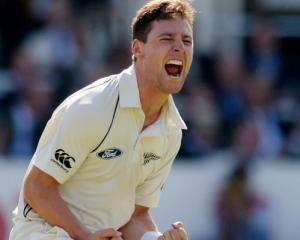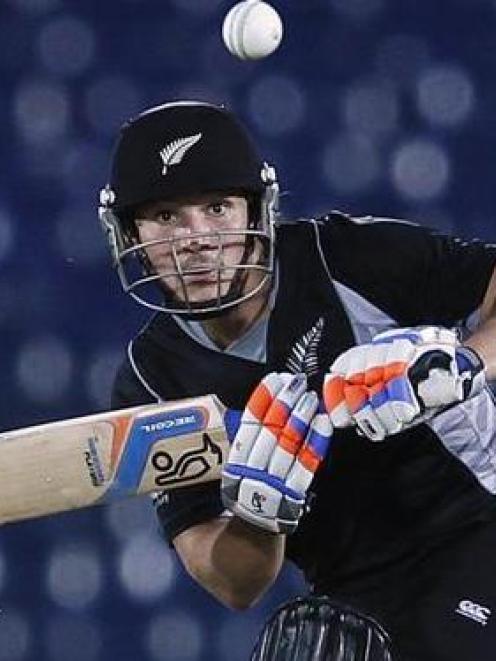
New Zealand Herald cricket writers Andrew Alderson and Dylan Cleaver look at the three main issues for selectors ahead of naming that final squad and which players will make the cut.
Who will open the batting?
Andrew Alderson: Brendon McCullum and Martin Guptill.
McCullum returns to takes the pressure off Guptill so he can fulfil more of an anchor role.
The captain still averages more as an opener in 80 innings (33.06) than he does from Nos 3-5 in 36 innings (30.96). If calamity strikes early, Kane Williamson can repair the innings at No 3.
The decision would help counter the alarming statistic that among test-playing nations, New Zealand's average ODI opening partnership over the last two years is the worst at 18.36 with a run rate of 4.17 and highest stand of 66. Next worst is the West Indies average partnership of 29.57.
McCullum and Guptill's average stand is 44.16 in 20 outings at a run rate of 5.43, including eight in excess of 50. That makes a compelling case. Even taking out potential outliers at the 2011 World Cup like unbeaten stands of 166 and 72 against Zimbabwe and Kenya respectively and 53 against Canada, the average is still 29.65. They last opened together in the semifinal against Sri Lanka.
However, establishing an injury back-up option is a priority. Anton Devcich and Dean Brownlie have shown promise but that needs fulfilment in the coming weeks. Their fielding skills would also be a World Cup asset, even as 12th men. Another option might be to use Tom Latham as a substitute opener, creating a more permanent space in the middle order for Jimmy Neesham.
Dylan Cleaver: Brendon McCullum and Martin Guptill.
It seems that they have gone away from the idea that Brendon McCullum is a middle-order "finisher" and now think he's more effectively used to set up the innings. I tend to agree, but only in certain conditions.
It is clear that they do not want McCullum exposed to spinners early in his innings, particularly those with an effective arm ball. Even with the ICC's recent, stringent enforcement of the 15-degree rule culling the practitioners of doosras and mystery balls, McCullum still struggles early against orthodox spinners. He doesn't pick it from the hand or through the air, relying instead on exceptional hand-eye coordination and bat-speed to get him out of trouble. This works when he's "in" but is far less effective at the start of his innings.
Which is a long-winded way of saying that McCullum and Martin Guptill are in pole position to open.
In ideal circumstances I'd prefer a left-right combination to complicate opposition bowling lines and field placements, but these two have enough class and, importantly, power to compensate.
If it doesn't work, expect a quick change to a Tom Latham-Guptill combination.
Which two out of Kyle Mills, Adam Milne, Matt Henry, Hamish Bennett, Doug Bracewell and Mitchell McClenaghan will join Trent Boult and Tim Southee in the 15-man squad?
Alderson: McClenaghan and Mills
With Mills' tournament experience such a valuable asset, it appears the McClenaghan/Milne/Henry triumvirate will contest one and, at a push, two spots, if a spare batsman, spinner or all-rounder are axed.
Milne's pace has always astonished but, in the past, he tended to be erratic. However, the 22-year-old has been consistently accurate in the UAE and appears to have lost none of his pace. He cleaned up the tail to take five for 33 for New Zealand 'A' against Ireland and took three for 24 against the United Arab Emirates when the ball sounded like the cracking of a whip each time it hit the keeper's gloves. Milne regularly bowled in excess of 150km/h in the first ODI against Pakistan.
However, McClenaghan has an impeccable ODI record. His 24.3 strike rate is the second best in history behind Australia's Ryan Harris for those who have delivered more than 1000 balls. He equalled Ajit Agarkar as the second fastest player to 50 ODI wickets in 23 matches. McClenaghan's expensive at 5.77 runs per over but Milne is hardly parsimonious at 5.42 in eight ODIs where his two wickets have come at a strike rate of 140.5.
Henry's also in contention with six ODI wickets coming at 18 balls a piece. What he might lack in pace, he makes up for with subtle movement.
Mills also needs to sustain form. His 237 ODI wickets have come at a mere 26.94, but in 2014 his seven wickets have come at 44.14. Bracewell and Bennett are injury contingencies.
I'll take McClenaghan over Milne and Henry for now. Why would the selectors build McClenaghan into such a confident, aggressive tour de force only to drop him when it counts?
Cleaver: Mills and Milne
By process of elimination, you can probably draw a line through Bennett and Bracewell, unless New Zealand endure a catastrophic run of injuries. This leaves four to go into two.
Tricky, very tricky. My guess is that these guys will have plenty of opportunity to bowl themselves out of the side between now and February.
Barring injury, you can pencil Mills in. His limited overs are really good, his experience in transtasman conditions invaluable and he will also be the sort of guy who adds value even when he doesn't make the eleven.
Henry has looked handy, but he probably hasn't done enough to warrant inclusion, yet. That for me leaves Milne and McClenaghan fighting for the final seam bowling spot. Milne's extra pace wins it for me. McClenaghan is a proven wicket-taker and would be unlucky to miss, but Boult's rapid ascension from test only to one-day certainty means there is less need for McClenaghan's left-arm variety, particularly with Corey Anderson also in the mix.
A tough, almost unfair call.
Would you pick BJ Watling?
Alderson: Yes, he's done everything asked of him in limited overs since being selected to lead New Zealand 'A' on the tour to England this year.
Traditional statistics such as averages weren't used as the complete gauge to performance. Players were assessed on target scenarios within games to see how they coped under pressure. Watling stood out with an average of 38.60 but, more importantly, a strike rate of 137 closing in the middle order. He also conceded no byes and took 19 catches with the gloves as the side went on to win seven out of eight completed one-day matches in England, including three in a tri-series against equivalent development sides from England and Sri Lanka. The only loss came via Duckworth-Lewis against Sri Lanka A pre-tournament.
Watling's inclusion would keep the pressure on Luke Ronchi and offer a reinforcement as a No.5 or No.6. Brendon McCullum does not want to return to the gloves and potentially aggravate his back, especially if he's opening and captaining the side as well. Tom Latham was asked by the selectors to be a specialist batsman because he's not seen as full-time keeper. Watling demonstrates the sort of stoicism which could galvanise a team facing high World Cup expectations at home. Get him on the bus.
Cleaver: No, that would be an unnecessary luxury when your squad includes Luke Ronchi, Brendon McCullum and Tom Latham who are all capable of donning the big gloves.
Watling is the glue that holds together New Zealand's lower test order and is one of the first picked in whites, but his one-day game is a work in progress. So far there has been little evidence that he has the raw power to close an innings and it is not as if his keeping is so good it warrants inclusion.
This is nothing against Watling, who has developed into a terrific, gutsy cricketer, but as much as the coach and captain might like having him around, his would be a spot that could be better utilised. It would allow the selection of a fifth seamer or an extra power hitter -- I would go with the latter.
Andrew Alderson's 15-man squad (if picked today): Corey Anderson, Trent Boult, Martin Guptill, Tom Latham, Mitchell McClenaghan, Brendon McCullum, Nathan McCullum, Kyle Mills, James Neesham, Luke Ronchi, Tim Southee, Ross Taylor, Daniel Vettori, BJ Watling, Kane Williamson
Dead-certs: Corey Anderson, Trent Boult, Brendon McCullum, Luke Ronchi, Tim Southee, Ross Taylor, Daniel Vettori, Kane Williamson.
Probables: Martin Guptill, Tom Latham, Nathan McCullum, Kyle Mills, James Neesham.
Possibles: Dean Brownlie, Anton Devcich, Matt Henry, Mitchell McClenaghan, Adam Milne, Colin Munro, BJ Watling.
On the outer: Hamish Bennett, Doug Bracewell, Colin de Grandhomme, Grant Elliott, James Franklin, Hamish Rutherford
Highly unlikely: Neil Broom, Andrew Ellis, Roneel Hira, Rob Nicol.
Dylan Cleaver's 15-man squad (if picked today): Corey Anderson, Trent Boult, Martin Guptill, Tom Latham, Brendon McCullum, Nathan McCullum, Kyle Mills, Adam Milne, Colin Munro, James Neesham, Luke Ronchi, Tim Southee, Ross Taylor, Daniel Vettori, Kane Williamson
Colin Munro is the wildcard player I have found room for by the non-selection of Watling. Although he is yet to convince at this level, his versatility, power and inventiveness at the crease could provide an x-factor in the right circumstances. Mitchell McLenagahan is my unluckiest player, just losing out in a head-to-head with Adam Milne for a fourth seamers spot. However, I'm not convinced yet by Nathan McCullum's claims. Is a second spinner necessary in Australian and new Zealand conditions? Possibly not. I wouldn't put it past the selectors to opt for an extra quick and leave McCullum, N, out.

